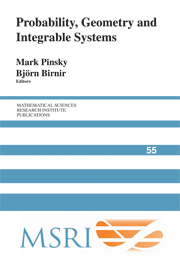Book contents
- Frontmatter
- Contents
- Preface
- Henry McKean: A tribute by the editors
- Bitangential direct and inverse problems for systems of differential equations
- Turbulence of a unidirectional flow
- Riemann–Hilbert problem in the inverse scattering for the Camassa–Holm equation on the line
- The Riccati map in random Schrödinger and random matrix theory
- SLE6and CLE6 from critical percolation
- Global optimization, the Gaussian ensemble, and universal ensemble equivalence
- Stochastic evolution of inviscid Burgers fluid
- A quick derivation of the loop equations for random matrices
- Singular solutions for geodesic flows of Vlasov moments
- Reality problems in the soliton theory
- Random walks and orthogonal polynomials: some challenges
- Integration of pair flows of the Camassa–Holm hierarchy
- Landen Survey
- Lines on abelian varieties
- Integrable models of waves in shallow water
- Nonintersecting Brownian motions, integrable systems and orthogonal polynomials
- Homogenization of random Hamilton–Jacobi–Bellman Equations
Preface
Published online by Cambridge University Press: 27 June 2025
- Frontmatter
- Contents
- Preface
- Henry McKean: A tribute by the editors
- Bitangential direct and inverse problems for systems of differential equations
- Turbulence of a unidirectional flow
- Riemann–Hilbert problem in the inverse scattering for the Camassa–Holm equation on the line
- The Riccati map in random Schrödinger and random matrix theory
- SLE6and CLE6 from critical percolation
- Global optimization, the Gaussian ensemble, and universal ensemble equivalence
- Stochastic evolution of inviscid Burgers fluid
- A quick derivation of the loop equations for random matrices
- Singular solutions for geodesic flows of Vlasov moments
- Reality problems in the soliton theory
- Random walks and orthogonal polynomials: some challenges
- Integration of pair flows of the Camassa–Holm hierarchy
- Landen Survey
- Lines on abelian varieties
- Integrable models of waves in shallow water
- Nonintersecting Brownian motions, integrable systems and orthogonal polynomials
- Homogenization of random Hamilton–Jacobi–Bellman Equations
Summary
This volume is dedicated to Henry McKean, on the occasion of his seventyfifth birthday. His wide spectrum of interests within mathematics is reflected in the variety of theory and applications in these papers, discussed in the Tribute on page xv. Here we comment briefly on the papers that make up this volume, grouping them by topic. (The papers appear in the book alphabetically by first author.)
Since the early 1970s, the subject of completely integrable systems has grown beyond all expectations. The discovery that the Kortweg – de Vries equation, which governs shallow-water waves, has a complete system of integrals of motion has given rise to a search for other such evolution equations. Two of the papers in this volume, one by Boutet de Monvel and Shepelsky and the other by Loubet, deal with the completely integrable system discovered by Camassa and Holm. This equation provides a model describing the shallow-water approximation in inviscid hydrodynamics. The unknown function u.(x; t) refers to the horizontal fluid velocity along the x-direction at time t . The first authors show that the solution of the CH equation in the case of no breaking waves can be expressed in parametric form in terms of the solution of an associated Riemann– Hilbert problem. This analysis allows one to conclude that each solution within this class develops asymptotically into a train of solitons.
Loubet provides a technical tour de force, extending previous results of McKean on the Camassa–Holm equation. More specifically, he gives an explicit formula for the velocity profile in terms of its initial value, when the dynamics are defined by a Hamiltonian that is the sum of the squares of the reciprocals of a pair of eigenvalues of an associated acoustic equation.
Information
- Type
- Chapter
- Information
- Probability, Geometry and Integrable Systems , pp. ix - xivPublisher: Cambridge University PressPrint publication year: 2008
